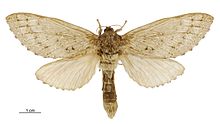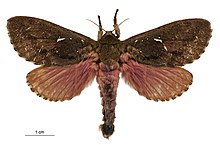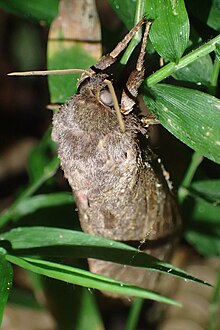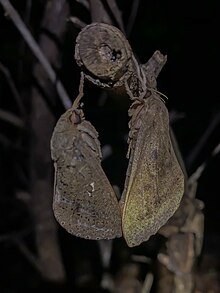| Dumbletonius unimaculatus | |
|---|---|

| |
| Female | |

| |
| Male | |
| Scientific classification | |
| Domain: | Eukaryota |
| Kingdom: | Animalia |
| Phylum: | Arthropoda |
| Class: | Insecta |
| Order: | Lepidoptera |
| Family: | Hepialidae |
| Genus: | Dumbletonius |
| Species: | D. unimaculata |
| Binomial name | |
| Dumbletonius unimaculata (Salmon, 1948) | |
| Synonyms | |
| |
Dumbletonius unimaculatus, also known as the forest ghost moth, is a species of moth of the family Hepialidae. It is endemic to New Zealand. This species is host to the vegetable caterpillar fungus Ophiocordyceps robertsii.
Taxonomy
This species was first described in 1948 by John T. Salmon as Porina unimaculata from specimens collected by Graham Turbott on the Three Kings Islands. In 1966 Dumbleton moved the species to a new genus and gave the new combination as Trioxycanus unimaculatus, the species name being made masculine to agree with the new genus. John Dugdale created the genus Dumbletonius in 1986, and moved this species into it in 1994, synonymising Dumbletomius sylvicola with it in the process. The male holotype specimen is held at the Auckland War Memorial Museum.
Description

The wingspan is 51–67 mm for males and 74–90 mm for females. The colour pattern of the forewings is complex in males and usually reduced or obsolete in female. The hindwings are unicolorous yellow, orange-yellow or pink. The bright colouration of the hindwing of the male of the species fades rapidly after death.
Distribution

Dumbletonius unimaculatus is endemic to New Zealand and can be found only in the North Island where it is regarded as being common.
Habitat
This species inhabits lowland native forest.
Life cycle

The female of the species can lay up to 10000 eggs amongst leaf litter in native forest. Larvae live two to three years in tunnels amongst the leaf litter and can grow to a length of 10 cm. The larva pupates in the tunnel it inhabits. The adult moth is on the wing from December to April.
Hosts and threats
The larvae of this species probably feed on fallen leaves.
The larvae are a host for the vegetable caterpillar fungus Ophiocordyceps robertsii. This fungus mummifies the caterpillar then grows its fruiting body from the caterpillar's head through the soil.
References
- ^ Nielsen, Ebbe S.; Robinson, Gaden S.; Wagner, David L. (2000). "Ghost-moths of the world: a global inventory and bibliography of the Exoporia (Mnesarchaeoidea and Hepialoidea) (Lepidoptera )" (PDF). Journal of Natural History. 34 (6): 823–878. doi:10.1080/002229300299282. S2CID 86004391.
- ^ Dugdale, J. S. (1994). "Hepialidae (Insecta: Lepidoptera)" (PDF). Fauna of New Zealand. 30: 58–59 – via Landcare Research New Zealand Ltd.
- Salmon, J. T. (1948). "New Species and Records of Lepidoptera from the Three Kings Islands, New Zealand". Records of the Auckland Institute and Museum. 3: 309–311. ISSN 0067-0464. JSTOR 42906019. Wikidata Q58676668.
- Dumbleton, L. J. (1966). "Genitalia, classification and zoogeography of the New Zealand Hepialidae (Lepidoptera)". New Zealand Journal of Science. 9 (4): 920–981 – via BUGZ.
- Dugdale, J.S. (19866). Trioxycanus Dumbleton, 1966 (Lepidoptera), a genus based on a misidentified type species, with proposal of new names for the taxonomic genus and species involved. Z.N.(S.) 2462. Bulletin of zoological nomenclature 43:46-49.
- ^ Hoare, Robert J. B. (2014). A photographic guide to moths & butterflies of New Zealand. Ball, Olivier. Auckland: New Holland Publishers (NZ) Ltd. p. 16. ISBN 9781869663995. OCLC 891672034.
- "Dumbletonius unimaculatus (Salmon, 1948)". www.nzor.org.nz. Landcare Research New Zealand Ltd. Retrieved 2017-09-28.
- ^ "Dumbletonius unimaculatus". Moths and Butterflies of New Zealand Trust. 2024-01-14. Retrieved 2024-05-08.
External links
- Dumbletonius unimaculatus discussed on RNZ Critter of the Week, 11 May 2024
- [REDACTED] Media related to Dumbletonius unimaculatus at Wikimedia Commons
| Taxon identifiers | |
|---|---|
| Dumbletonius unimaculatus | |
| Dumbletonius sylvicola | |